Are we there yet? One may well ask When the Todmorden panels are going to be completed. If I keep chipping away at the task, hopefully this summer visitors to the site will be able to interpret it when staff are not around, by reading a few facts and stories, and seeing some images of Todmorden's amazing history.
We've already been through a round of writing two summers ago, but the finished product needed refinement, and more accessible text and images. There are a lot of ways to approach this interpretive device, and presented here is one version - image heavy, much lighter text, more story oriented, and trying to illustrate an interpretive framework developed in the summer of 2010: People, Process, Place - the people, the industry and the ecology of Todmorden Mills.
If you see anything on the four panels that are posted here that you question for any reason, please comment. This is a public forum, and I hope I can workshop the approach here.
Monday, June 11, 2012
Sunday, June 10, 2012
Cross Valley Connectors
Todmorden’s roads and bridges were a vital transportation network for trade and travel across the Don Valley.
Before 1800, when the first mills were built at Todmorden, the volume and velocity of the Don River was much greater than it is today, and the river was the first transportation route through the valley. In summer, it was navigable by boat or canoe from the bay up to the flood plain south of Todmorden. In winter its frozen surface created an clear highway for horse-drawn sleighs carrying people and merchandise to and from farms and industries north of the city.
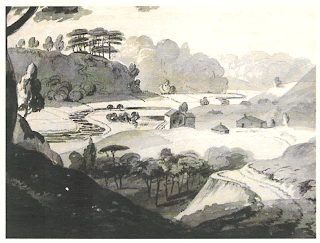 |
| John Elliott Woolford "Mill Three Miles from York" 1819. Library and Archives Canada, Acc. No. 1979-9-29 |
A rare paved road uncovered at Todmorden Mills
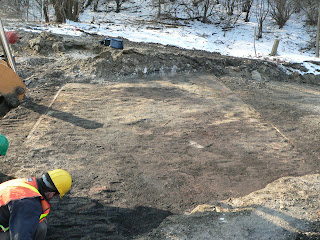 |
| Photos Historic Horizon, Inc. |
 |
| Todmorden's bridge linked the two sections of the brick road. |
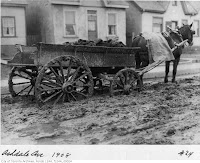 |
| Toronto, 1908 Toronto Archives Fonds 1244 William James |
Muddy road conditions plagued early Toronto travellers and merchants. "The roades are so bad they are killing our horses,” wrote brewery owner, William Helliwell in his journal in 1833.
Land grant recipients in Upper Canada, such as the settlers at Todmorden, were required to help in clearing land and improving roads, but paved, or "macadamized" roads were rare in the 1800s. Even into the 20th century many Toronto roads were rough unpaved wagon tracks, sometimes impassable in wet weather.
 |
| The Todmorden bridge crosses the Don River and connects the two sections of the brick road, 1931. |
Before construction of the Don Valley Parkway, the Don River flowed in a large
meander, or oxbow, under Todmorden’s bridge.
The bridge linked the two sections of the brick road, connecting Pottery Road to the Brick Works on the other side of the valley. The old brick road ran in a straight line from the bridge to the Brick
Works, passing under the railway trestle.
 |
 |
| Todmorden's bridge before the 1920s elevation of the embankment. |
Todmorden was
frequently threatened by destructive floods, and the embankments for the bridge
have been elevated several times to lift it above flood level. The bridge
piers, built in layers of different materials, record multiple efforts to
protect this crucial transportation link.The flagstone layer dates from 1920, while the piers at the base are one of earliest of examples of the use of poured concrete in Toronto.
Between 1847 and 1900, Todmorden’s mills closed, and their buildings were repurposed to provide housing for Brick Works employees and stables for horses. As the site was elevated with landfill to protect it from the flooding river, earlier structures, including the first storeys of the paper mill and the brewery, and their mill races, were filled in and buried.
Construction
of the Don Valley Parkway bisected Todmorden Mills. The Don River was channelized and moved to the western side of the expressway. Pottery Road, which once ran across the
valley and up the Cudmore Creek ravine, now ends at Bayview Avenue.
A 1955 aerial plan for the expressway construction shows the former paths of the
Don River oxbow, Pottery Road, Todmorden’s bridge and head mill race, and the road to the
Brickworks.
Tuesday, May 29, 2012
Brewers and Brewsters at Todmorden Mills
In 1821, English
immigrant Thomas Helliwell purchased a lot of land at this site and established
one of Toronto’s first breweries. When Thomas died in 1823, his widow Sarah
Lord Helliwell became brewster (female brewer) and ran the business with three of her
sons, Thomas Jr., Joseph and William. Beermaking was a respectable occupation
for women in 19th century Upper Canada, and brewsters were not
uncommon in the trade, often taking over a beermaking operation when a
brewmaster husband died.
Sarah's daughters, Mary and Elizabeth, married paper mill owners, Colin Skinner and John Eastwood, connecting Todmorden's businesses through family ties.
Beer requires
only three ingredients: grain, water, and yeast. Hops is often added as a
flavouring and a mild preservative. To make beer, the brewer cooks a mixture of
water and sprouted grain (called malt) in a large vat called a mashtun. He
drains off the liquid, now called wort, and adds hops, and then boils the wort
in a special kettle called a copper. The wort is then allowed to cool, and
yeast is added, which ferments the brew into an alcoholic and bubbly beverage.
By 1830, the expanding Don Brewery dwarfed the nearby paper mill, and included a multi-story brewhouse, a distillery, a malthouse, and a grist mill. Todmorden’s malthouse stretched along the length of the hillside, measuring nearly 25 metres. A two- or three story stone house was also part of the complex. Several mills, farm buildings and stables stood nearby, and the brewery was surrounded by vegetable gardens, meadows, orchards and hops fields.
Sarah's daughters, Mary and Elizabeth, married paper mill owners, Colin Skinner and John Eastwood, connecting Todmorden's businesses through family ties.
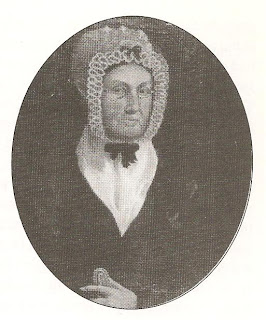 |
| Sarah Lord Helliwell, 1775 - 1842 |
 |
| The Helliwell brewery was built into the hillside. |
The Don
Brewery operated for nearly thirty years, until it was destroyed by fire in
1847.
The Don Valley
provided an excellent environment for a brewery: the Don River powered the
brewery’s water wheel, driving its pumps and machinery, natural springs in the
hillside provided pure water for beermaking, and the steep ravine supported a
stepped foundation for the brewery’s gravity-fed processes and deep cellars.
 |
| A water wheel drove the rollers in the Don Brewery's malt mill. |
 |
| Todmorden, 1835, showing an extensive brewery. |
By 1830, the expanding Don Brewery dwarfed the nearby paper mill, and included a multi-story brewhouse, a distillery, a malthouse, and a grist mill. Todmorden’s malthouse stretched along the length of the hillside, measuring nearly 25 metres. A two- or three story stone house was also part of the complex. Several mills, farm buildings and stables stood nearby, and the brewery was surrounded by vegetable gardens, meadows, orchards and hops fields.
Beer is a
perishable product and before the days of year-round refrigeration, beermaking
was a winter time occupation, providing seasonal employment for farm hands
after the fall harvest. When in full operation, the Don Brewery employed 20 men
as maltsters, brewers and labourers. A typical working day in the brewery would
be 12 – 14 hours long, and some workers were required to live on site. Children
also worked here seasonally, in the autumn, as hops pickers.
 |
| The Helliwells shipped beer from their wharf at Market Street, Toronto |
 | |
| William and Joseph Helliwell, brewers. |
The Don
Brewery transported kegs of beer by horse-drawn wagon to the city centre. Thomas
Helliwell Jr. operated a wharf near St. Lawrence Market, and shipped beer
around the north shore of Lake Ontario. Todmorden also supplied the garrison at
Fort York, an active military site during the period, as well as many local
taverns and inns. Montgomery’s Tavern, made famous as a gathering point for the
1837 rebellion, was one of the Don Brewery’s customers.
The Helliwells also operated a distillery at Todmorden. Rye whiskey was its primary product.
 |
| Todmorden's brewery building served as a stables in the 1900s. |
After the fire
in 1847, the Taylor family acquired the brewery property and adjoined it to
their Brickworks operation, using the surviving structure as a stables and
storage building. Eventually the Don Brewery’s first story and cellars were landfilled
with debris from Brickworks kilns. Today’s brewery building represents only the top story of the original
structure.
Sister Site - Mary, Betty and Rhoda!
Want to have some fun with interpreting Todmorden Mills? Looking for a critical analysis? Check out the Sistahs at:
http://marybettyrhoda.blogspot.ca/
http://marybettyrhoda.blogspot.ca/
Saturday, May 26, 2012
Living at Todmorden
As industry
grew in the Don Valley, settlement followed.
Temporary camps and rough log houses were replaced by more permanent dwellings
of local stone or sawn lumber. Later – especially after the Brick Works opened
in 1889 – brick houses became more common.
Helliwell House
Adobe construction provides good insulation, retaining heat in winter and keeping an interior cool on hot days. Helliwell House's wide eaves also provided protection against the elements, shedding snow and shading the upper windows against the summer sun.

Todmorden’s frame cottage reflects the Regency style of the early 19th century, with sidelights and a transom at its central front entrance. Legend has it that the house was originally built elsewhere and later moved to this spot. Archival maps and archeological evidence point to an 1850 date for cottage’s construction, or possible relocation.
 Unusual for its time, the cottage has its own well in the basement, providing spring water to its tenants. During the 1940s, the central hallway was dominated by a large woodstove, the only ‘central’ heating in the house.
Unusual for its time, the cottage has its own well in the basement, providing spring water to its tenants. During the 1940s, the central hallway was dominated by a large woodstove, the only ‘central’ heating in the house.
Archival photographs of other Todmorden houses, now demolished, record the stark contrast in lifestyles between mill owners and their employees. Perched at the top of the ravine at the corner of Pottery Road and Broadview Avenue, the powerful Taylor family lived in a lavish 19-room mansion called Bellehaven. The Taylors owned the Brick Works and several paper mills in the Don Valley.
 In the fall of 1931, many of these homeless were employed by the Canadian government in a make-work project to construct the Trans- Canada Highway in Northern Ontario, and their Don Valley shantytown was demolished.
In the fall of 1931, many of these homeless were employed by the Canadian government in a make-work project to construct the Trans- Canada Highway in Northern Ontario, and their Don Valley shantytown was demolished.

The designs
of the two surviving residences at Todmorden – the grand Helliwell House and
the single-storey wooden cottage – reflect the social and economic status of
their residents. Although both houses
had fine features, such as fireplaces, wall paper and woodwork, neither had
running water or bathrooms. After
Todmorden became the property of the Taylor family in the 1850s, both houses were
rented to Brick Works employees and other tenants until 1950.
 |
| Helliwell House, built 1838. |
The large, extended Helliwell family, described as the "great colony of Helliwells" by a neighbour, operated the Todmorden brewery from 1821 until 1847. Of several houses they built on the property, only Helliwell House survives. Built in 1838, it is a rare Toronto example of an adobe or 'mud brick' house. The single storey frame portion of the house represents an earlier, more modest family residence.
Adobe construction is sometimes called 'mud brick' because it uses sun-dried, rather than kiln-fired bricks. A mixture of clay, sand and straw is pressed into a wooden mold, and the block-sized bricks are allowed to dry in the open air. Once the adobe wall is stuccoed, it is impermeable to rain.
 |
| Demonstrating adobe brick manufacture. |

Todmorden’s frame cottage reflects the Regency style of the early 19th century, with sidelights and a transom at its central front entrance. Legend has it that the house was originally built elsewhere and later moved to this spot. Archival maps and archeological evidence point to an 1850 date for cottage’s construction, or possible relocation.
 Unusual for its time, the cottage has its own well in the basement, providing spring water to its tenants. During the 1940s, the central hallway was dominated by a large woodstove, the only ‘central’ heating in the house.
Unusual for its time, the cottage has its own well in the basement, providing spring water to its tenants. During the 1940s, the central hallway was dominated by a large woodstove, the only ‘central’ heating in the house.
 |
| Bellehaven, built 1887, demolished 1950s |
 |
| Worker's cottage on Pottery Road |
 |
| Tar paper shack in the Don Valley |
During the Great Depression of the 1930s, the Don Valley became dotted with the makeshift homes of hundreds of unemployed men who arrived by rail looking for work. These “cave and shack dwellers”, as they termed themselves, assembled a kind of hobo town called The Jungle.
During the winter of 1930, the Don Valley Brick Works allowed the homeless to sleep inside the brick kilns, after the bricks were fired and left to cool slowly overnight.
By June of 1931 one hundred men were living in the Brick Works, and two hundred more said to be sleeping in the open by the Don River.
 In the fall of 1931, many of these homeless were employed by the Canadian government in a make-work project to construct the Trans- Canada Highway in Northern Ontario, and their Don Valley shantytown was demolished.
In the fall of 1931, many of these homeless were employed by the Canadian government in a make-work project to construct the Trans- Canada Highway in Northern Ontario, and their Don Valley shantytown was demolished.
During World War II,
Todmorden was the site of a small prisoner-of-war camp. Most of the camp’s
inmates were German merchant marines. The camp consisted of a dozen wood frame cabins
located in a fenced-off area on the ‘flats’ where the current Todmorden parking
lot lies.
Some of these
prisoners-of-war were put to work in the Brick Works during their confinement
and repatriated after the war. It’s said that at least one of them, apparently
enjoying life in the valley, later returned to Canada and found work once more
in the Brick Works, where he was recognized by one of his former coworkers.
River Power at Todmorden Mills
 |
| "Taylor Bros. Mill on the Don River" by D.C. Grouse, 1810 |
From a single
water-powered lumber mill operating on the Don River in 1795, Todmorden grew through
the 1840s into a busy mill and brewery complex. Until steam power arrived after 1850, Todmorden relied on water power supplied through a
system of mill races and water wheels.
A mill race is a manmade channel that diverts
part of a river's flow into the water wheel of a mill. The head race carries water to the wheel, and the tail race returns
the water to the river, carrying away waste products from the mill. Mechanical sluice gates control the level of the
water in the mill race.
 |
| A mill pond would form above the dam, storing water power. |
Todmorden’s Two Mill Races
 |
| Todmorden's head race split in two north of the paper mill, 1876 |
The west race remained as an uncovered watercourse, running between the paper mill building and what is now the Don Valley Parkway.
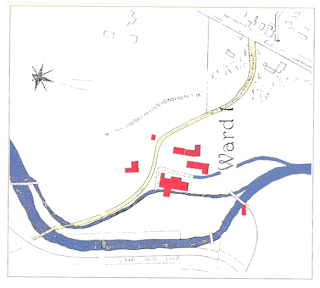 |
| Todmorden, 1910. The underground east race is marked as a dotted line. The west race runs from the dam, along Pottery Road. |
Fire destroyed some of Todmorden’s industry in 1847. As steam power became available, the need for water power declined, and Todmorden’s mill races were ultimately used as drains for steam-powered mills.
Todmorden’s West Mill Race
In 2004, archaeologists uncovered a portion of the wheel house and west race with its preserved wooden sluice gate still in place.
Todmorden's East Mill Race
 Todmorden’s
mill races were gradually filled in by debris from both the Brick Works and excavation debris from construction projects in the booming city of Toronto. Todmorden’s underground
east mill race remains intact beneath several metres of landfill, and a portion of
its 4-metre-wide arched roof was discovered by archeologists during excavations around the paper mill building in 2000.
Todmorden’s
mill races were gradually filled in by debris from both the Brick Works and excavation debris from construction projects in the booming city of Toronto. Todmorden’s underground
east mill race remains intact beneath several metres of landfill, and a portion of
its 4-metre-wide arched roof was discovered by archeologists during excavations around the paper mill building in 2000.The underground east race resurfaced at a spot near the brewery and ran along the east bank of the Don River until it emptied into the south bend of the oxbow. One of Todmorden’s tail races is still visible near the entrance to the Wildflower Preserve, a partially filled ditch running to the west of the path.
A mill race is a powerful and sometimes dangerous watercourse. One of William Helliwell’s children died in an accident at the mill in 1844, possibly drowning in the millrace.
Steam power came to Todmorden in the 1870s, and the paper mill's landmark chimney was built. Water power became a secondary, back-up system to coal-fired steam engines. As power generation changed, Todmorden’s mill races continued to in use, but mostly as sewers for factory wastes. Chemical effluent from paper mills and organic wastes from saw mills damaged the water quality of the Don River.
In 1917, Todmorden was acquired by a Toronto construction company and used as a landfill for excavation debris from downtown building sites. The first storeys of the
paper mill building and the brewery, as well as Todmorden's mill races, were buried under several metres of landfill.
Saturday, May 12, 2012
Thinking in 3 directions
I'm working on an cut-away illustration/diagram of a 19th century brewery that used to stand on the Don River near Broadview Avenue. The building burned down in 1847, but the landscape was never redeveloped. From the brewer's diary (which he kept almost every day for many years) I can glean small references to the layout of the brewery, and its malt house, brew tower etc. In addition, beer enthusiasts everywhere have created a large body of educational material about how it might have functioned inside. From these three directions, I'm able to imagine what the brewery looked like, and how people worked inside of it. I'm visually reconstructing something that hasn't stood on that spot in over 150 years.
Subscribe to:
Posts (Atom)




